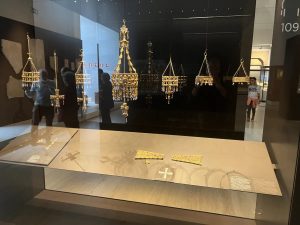Setting the scene
The week in Barcelona with our Swiss friend Simone was truly a blessing and demonstrated how minor initial conditions affect the trajectory of relationships and experiences in life. If Simone had been assigned to any other high school in America for her study abroad, this week in Barcelona would not have happened the way it did and probably would not have happened at all. Simone is the one who made the big leap and accepted the risk of going to a foreign country for a year as a high school student. Yet somehow it feels as if Lyn and I have benefited from that decision without having to take any risk ourselves. It almost doesn’t seem fair and it’s part of the reason we value our friendship with Simone so much.
That feeling of gratitude and dumb luck got reinforced this past week during our visit to the city of Valencia and the charming town of Pedreguer as guests of a wonderful couple named José and María.
Our connection with José and María is that their daughter, Irene, also did a foreign exchange program for a year of high school just like Simone did, but it was in 2015 rather than in 1986. Three decades apart but pretty much the same story; Irene made the big leap and our family benefited without having to take any risk of our own. In fact, Irene was a godsend because that was Natalie’s junior year of high school and we had just moved from Okinawa, Japan so Natalie was coming into a high school environment that felt almost as foreign to her as how Irene felt coming from Spain.
Natalie and Irene got along great and have remained in touch. After Natalie graduated from high school, she and Lyn took a two-week trip to Spain and spent most of the time with Irene visiting Valencia, Madrid, Barcelona, and Irene’s hometown of Pedreguer. When Natalie studied abroad in London, she and Irene took advantage of Europe’s discount airlines and met up for a weekend in Luxembourg (because why not?). After Natalie graduated from college, she took a trip to Europe and met up with Irene in Barcelona for a few days. When they get together, it’s fun to watch because the chemistry of their friendship is very organic. Irene is naturally curious with a very amicable and fun-loving personality. When you meet her parents, it’s easy to see that the manzana didn’t fall far from the tree.
Thanks to Lyn’s visit to Pedreguer in 2017 and to Irene staying in contact with Natalie, we have gotten to know Irene’s family over the past few years. During the pandemic, we talked on FaceTime to exchange holiday greetings, but I had never met them in person until this past week.
I don’t want to disclose too much personal information, but I think I am on safe ground to share three things about José that are important to understanding who he is:
- José is a senior manager in the IT Department at the University of Valencia and has a commanding knowledge of all things network-related. He has the mind of a “techie” but the heart of a thinker and leader, which obviously makes him very well respected in his professional environment.
- José is an impressively accomplished amateur (ham) radio enthusiast. He has won multiple awards and contests for his technical skill and passionate pursuit of ham radio excellence. The antennae outside their house and his “radio room” inside the house are something to see (their neighbors may not agree but I know that I was impressed). If you know someone with a ham radio that can talk to Spain, chances are they have talked with José (better known as EA5DFV in ham radio world).
- José is the most enthusiastic Bruce Springsteen fan I have ever met. His knowledge, his concert attendance, and his collection of music, books, and DVDs is impressive and conveys an appreciation for “The Boss” that is transcendent. I’ve always LIKED Bruce Springsteen and I know more of his songs than the average 52-year old but I am nowhere near the level of fandom as José. I loved the 2019 movie “Blinded by the Light” because one of its implied messages is that foreigners (and I am not using that word pejoratively) somehow see and appreciate Bruce Springsteen’s poetry about America more clearly and more passionately than many Americans. This seems to be the case with José and perhaps with many Spanish people. We watched a few songs (most notably “Badlands”) from a DVD of a Bruce Springsteen live in Barcelona concert that José and María attended on October 16, 2002 and it was impressive to see the energy of the audience matching Bruce Springsteen’s legendary energy on stage. José said it almost felt like Bruce Springsteen didn’t know how to end the concert because the crowd never let up. Ironically, we watched that DVD on October 15, which was just one day shy of that concert’s 20th anniversary. And be aware, Bruce Springsteen is going on tour in 2023. José says he will be ready when the ticket sales for Spanish venues go live. Last time, he had three laptops ready to go (did I mention he’s a techie?) and has every intention of getting tickets again.
Any one of these three accomplishments would be impressive on their own, but José is one of those people who is bursting with energy and knows how to focus it to be all these things at once.
María was born and raised in Pedreguer and is now physician. She is more reserved than José but has an obvious intellect and awareness that convey warmth and trust. We loved talking with her about a wide range of topics from parenting to local history to education to Spanish medical care; on every topic she had a lot of wisdom to share.
Both José and María speak excellent English. Lyn could converse with them in Spanish, during which times was at my typical 50% comprehension. Spanish, however, is a second language for most people in this region. Their first language is Valenciano, which is a dialect of Catalan.
As a refresher and perhaps a clarification of my previous comments, Catalan is a Latin based language that evolved in the modern-day Pyrenees region (French-Spain border) and is spoken in the south of France, three regions of Spain (Barcelona, Valencia, and the Balearic island), Andorra (where Catalan is THE sole official language), and even one small part of Italy on the island of Sardinia (an artefact of Catalonia’s golden age of expansion, diplomacy, and conquest). If you visit Catalonia and feel like you maybe didn’t learn Spanish as well as you thought, it’s probably because you are not hearing Spanish most of the time, but rather Catalan. You’ll even see a lot of websites that end in .cat for Catalonia rather than the more common .es for Spain.
Apart from the language, I advanced my amateur understanding of the Catalonian identity a few more inches (excuse me, a few more centimeters) during our visit. Four days is not enough to reach any conclusions as an outsider but the more we peeled the onion of Catalonian identity and language, the more fascinating it got.
Jose and María live in a town called Pedreguer, but they also have nice little apartment in the heart of Valencia. They graciously offered to let us stay in the apartment so Lyn and I spent a day in Valencia on our own before linking up with José and María for a weekend visit to Pedreguer.
Arrival in Valencia and visit with St. Nick (October 13, 2022)
After saying goodbye to Simone in Barcelona, Lyn and I took the metro and boarded a train from Barcelona to Valencia (3.5 hours). When we arrived at 3:30, our friend José was waiting for us. He was easy to identify as we came off the platform because he had told us he’d be wearing his Panama hat. We walked a short distance from Valencia’s Estació del Nord (Valenciano) to José and María’s city apartment. José showed us around and presented us with some bread, cheese, jamón serrano, and a bottle of wine as a welcome gift. We walked with José to the nearby underground parking lot where he was parked and then he departed. María and José live an hour away from Valencia, so it was extremely kind of him to make the trip to the city for the sole purpose of meeting us and letting us into the apartment. Fortunately, José drives a Tesla so the $8/gallon gas (and the associated carbon footprint) alleviated our feeling of guilt for his trouble. We made a plan to spend the following day on our own in Valencia and then meet up with José and María the day after.
We wasted no time breaking into the bread, cheese, jamón, and wine then set off to explore the city on foot for the evening. Lyn had been to Valencia in 2017 with Natalie and Irene so had some ideas about the highlights we needed to see. First on her list was the Church of San Nicolas, also known as the “Sistine Chapel of Valencia”. The nickname is not an understatement. This church is notable because it has a gothic (15th Century) exterior and an elaborate baroque (17th Century) interior.
We listened to an audioguide (English for me; Spanish for Lyn) while we toured the church. The volume of information was enormous and the artwork is very detailed and dense. The audioguide does a pretty good job of conveying that every image or scene not only has a very specific meaning, but that you could spend hours and hours on Google and Wikipedia drilling down on each one and still not understand everything being represented. For example, in addition to honoring Saint Nicholas (who lived in modern Turkey in the 4th Century), the church also was dedicated to St. Peter Martyr (also known as Saint Peter of Verona) who was an Inquisitor in the Lombardy region of Italy in the 1200’s and was successfully converting Cathar heretics back to Roman Catholicism when he was assassinated by a group of Cathars who were unhappy with his success. He was canonized 11 months later, a record that still stands for the fastest path to sainthood. This is just an example of how deep the history goes.
One other interesting item in the artwork on the ceiling is that it displays the nine orders of angels in the Catholic doctrine. According to the audioguide and Wikipedia, these orders are grouped in three spheres as follows:
- First Sphere: Seraphim, Cherubim, Thrones
- Second Sphere: Dominations or Lordships, Virtues, Powers or Authorities
- Third Sphere: Principalities or Rulers, Archangels, Angels
In the depictions of Saint Nicholas and other religious figures on the frescoed ceiling, the proximity and type of angels around them conveys relative importance. To a casual observer (like me), this nuance is completely lost. To a scholar of theology or art history, though, visiting this church is like seeing theological Marvel universe in one big architectural comic book.
The last notable feature to point out is the “rose window” in the back of the church which is a beautiful work of stained glass but also contains a rather prominent six-pointed Star of David. Even a casual observer (like me) recognizes the star as a salient design feature. In the audio guide, the explanation for the design is that it is symbolic of the fact that “Jesus was a Jew”. Knowing a little of bit of the Catholic Church’s uncomfortable history in Spain (most notably, the Spanish Inquisition), this didn’t quite satisfy my curiosity. Although it is an accepted fact that Jesus was technically Jewish, it’s not all that common to see the Star of David in churches. It’s also not unprecedented. I did some digging on this question and found a fascinating blog site talking about Valencia’s history as a city that once had one of the Mediterranean’s largest and most vibrant Jewish populations in the 1100-1200s. The fate of this community took a rough turn in the 1300-1400s with the Black Death instigating an initial round of anti-Semitism (scapegoating is always the progeny of fear and ignorance) and then the Spanish Inquisition in the 1400s which, by its end, eliminated nearly all traces of the Jewish community ever living there. The author of this blog suggests that perhaps this church window, which was completed in 1354, may have been influenced by Jewish craftsmen and is one of the few surviving remnants of that community. If this is at all interesting to you, I’d recommend taking a look at his blog. He cites no references, but it seems pretty well researched and balanced:
http://www.patrickcomerford.com/2020/01/the-lost-sephardic-legacy-of-mediaeval.html
And in a completely different interpretation, maybe two equilateral triangles inside a circle just makes good architectural sense for stained glass window design and its association as a symbol of Jewish faith postdates the construction of this church. In this case, the interesting history and unfortunate fate of Valencia’s Jewish community is purely coincidental with the Rose window of San Nicolas. It would certainly not be the first time modern thinking has mis-ascribed the meaning of an historical symbol. According to Wikipedia, the Star of David did not achieve “stardom” as a symbol until the late 19th century. The great thing about being an amateur is not having to take a position on this question, although I do think the audioguide misses the mark in its explanation.
Here are the photos from our visit. Lighting was a bit of a challenge and we failed to get a picture of the outside, partly because it’s just not that much to see on the outside. In fact, the dull exterior is a big factor in how much the interior blows your hair back when you walk in and see it for the first time.
It feels almost absurd how much this church assaults your senses, but it all works together and the overall effect is reverence and serenity. Wherever you look, it’s telling a story even if you aren’t entirely sure what that story is exactly.

Nice catch. This is one of many statues in the church with superb detail and intended to convey a very specific message. The audioguide told us who this is and the significance of the fish, but I can’t remember exactly who. Note the seashells on the angel’s (or saint’s?) shoulder.

These are not the altar at the front of the church but one of 8 or 10 side chapels, each with their own design and purpose. What could be looking at in the second photo?
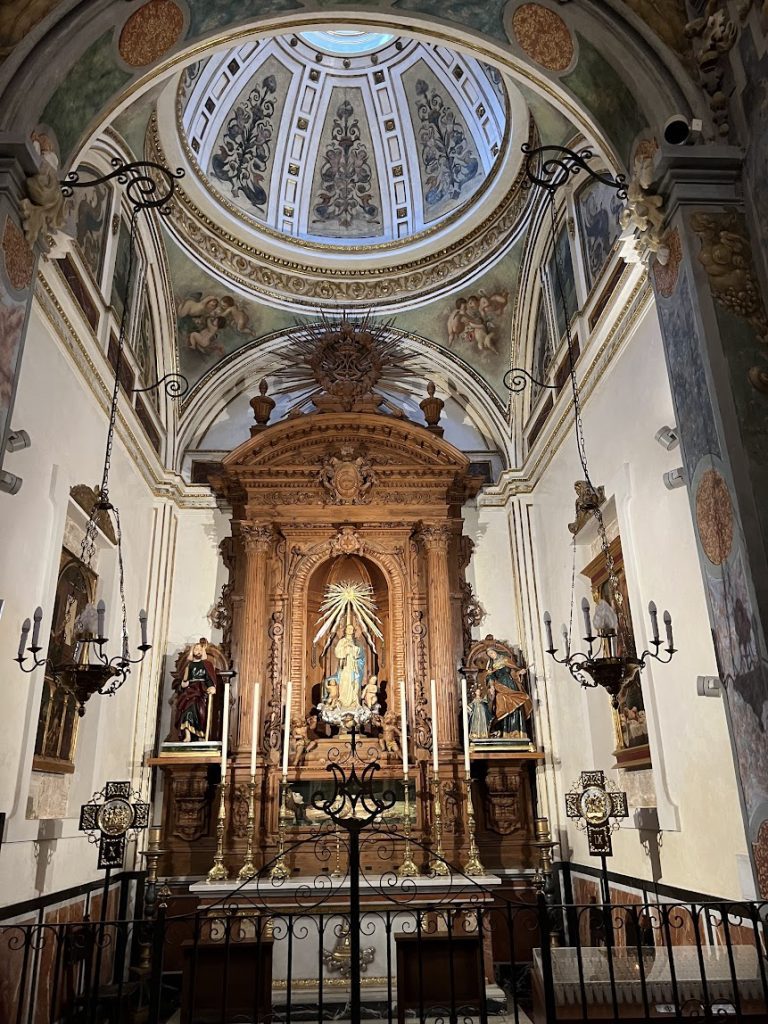

THIS is what he was looking at. At the bottom of this photo you can see the top of the chapels in the two preceding photographs to give you a sense of proportions and scale. The windows pivot and were louvered to allow air circulation. As I ponder my post-Navy career options, I’m thinking of becoming a chiropractor in Valencia; this chapel must generate a ton of “sore neck” business.



Once you start looking for the angels, you realize they everywhere in the artwork.
THIS is the front altar. You can see Saint Peter Martyr in the middle on the left with the curved sword cutting into his head (apparently he was assassinated with a blade) and St. Nicolas on the right. This church honors both of these saints, who lived 800 years apart.

The Star of David jumps out for even the most casual observer. Symbols change over time, so it’s hard to know whether this window is a link to a past age when Valencia had a thriving Jewish community or if six-pointed stars were a common architectural feature that transcends Jewish identity. As further proof that the meaning of symbols can change of time, the artisans who built this could have never imagined some viewers would see a “the mouse” hiding amid the beautiful stained glass.

In one of the chapels were two paintings of some contemporary saints. If you want an interesting read, look up Saint Edith Stein (Jewish-born, converted Catholic who died at Auschwitz), Saint María Goretti (a poor farm girl who died during an attempted rape at age 11), or Maximilian Kolbe (a Catholic priest who volunteered to die in place of a Jewish man at Auschwitz. He also had an amateur radio license (SP3RN) and thus is the patron saint of radio operators). All three Wikipedia articles are fascinating. On the opposite wall, a similar painting included Mother Teresa and Padre Pio (who we know well from our time living in southern Italy).

Jolly old Saint Nicholas. This statue is at the front of the church and has its own kneeler so he can lend his ear to the requests of the faithful. According to the audioguide and Wikipedia, St. Nick was born to fairly affluent parents. The pictures on the ceiling conveyed several stories in his journey to sainthood. Among the more popular and lasting stories is how he secretly dropped small bags of gold through the windows of a house in which a family lived that had fallen on hard times and couldn’t afford the dowry for their three daughters (better dowry equals better husband). This is supposedly the origin of secret gift giving by St. Nicholas and the basis of Santa Claus. Neither the audioguide nor Wikipedia made any mention of toymaking elves or flying reindeer. Some things remain a mystery. He sure has the beard though.

I didn’t mention that our visit was only 45 minutes because the church was closing and we were the last people to leave. One nice thing about the “Sistine Chapel of Valencia” is that it has about 1/10,000th fewer tourists of the actual Sistine Chapel in Rome, so you can really soak in its mood without feeling like you’re in a Sistine mosh pit. My favorite memory of Rome’s Sistine Chapel is the Vatican official walking around with a one-word sign and saying “SILENCIO…SILENCIO” loudly enough to be heard over the not-so-silent din of voices. No need for that at St. Nicholas, especially if you go the last hour of the day in the tourist off-season.
We spent the rest of our evening enjoying transition into sunset and all of the Valencians coming out for their evening walk. Then we had supper at a restaurant José recommended to us near the apartment and, wow, was it good.
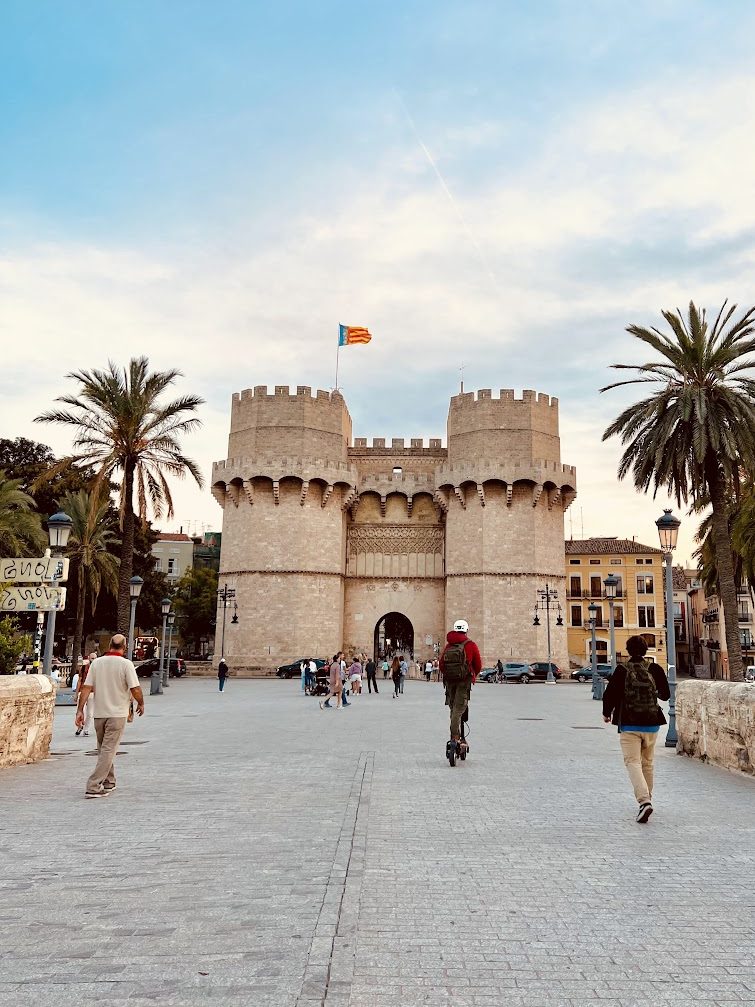
The Torres de Serrano built in 1392 (one hundred years before Chistopher Columbus arrived in the Americas). Couple things to note in this photos:
- The flag flying is the flag of Valencia; has the four red stripes on a yellow background which is the symbol of Catalonia and also has a blue field with a “fancy” heraldic design. Valencia is a part of Catalonia but also has its own distinct identity and dialect.
- The graffiti on the sign on the left is a continuation of a theme we have seen since Modena and Marseille (not so much in Iceland or Austria). Modern Europe definitely has a problem with spray paint control. which certainly is better than having a problem with gun control.
- Guy on an electric scooter; these are everywhere in Spain as a mode of transportation (they are not just for kids anymore).
- Palm trees at 39.5N, the same latitude as Philadelphia, Kansas City, and Denver.
- Valencia appears to be friendly to balding men. One more reason I like this place so much.
Plaça de la Virgen. Plaça, of course, is Catalan (or Valenciano) for Plaza.

In the Plaça de la Virgen, Neptune is in fountain surrounded by scantily clad ladies. “Created by local sculptor Silvestre Edeta, this work of art is actually an allegorical representation of Valencia’s Turia River and its eight irrigation ditches.” source: https://veebrant.com/valencia-plazas/.
The big church in the middle is the Cathedral of Valencia, which also has a Star of David in its circular stained glass window (visible just above the right shoulder of the rightmost water bearer). This window is also discussed in the previously mentioned blog post about the Jewish community that once lived in Valencia.

We went into the salmon colored church on the left side of Plaça de la Virgen (as viewed in the photo of Neptune) and found a number of Valencianos praying. As we sat there admiring the beauty and tranquility of the church, the bells started ringing and a priest came out to perform Mass. We awkwardly skedaddled.


Another elaborately painted ceiling. This reminded me a little bit of the U.S. Capitol building with George Washington looking down from his heavenly perch.
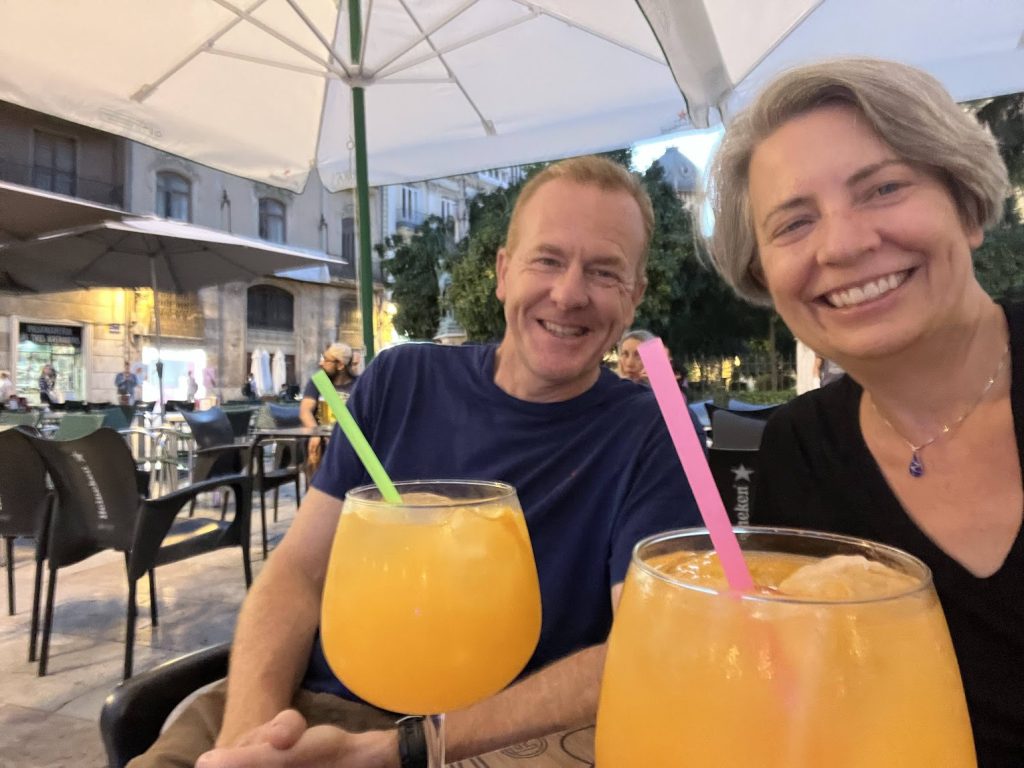
Lyn recommended we visit San Nicolas and it was a great call. She also recommended we order the local signature cocktail called “Agua de Valencia” at an outdoor cafe. It’s a mix of cava (sparkling wine), vodka, orange juice, and gin. Perhaps the venue we chose on Plaça de la Virgen was too touristy; we agreed that the drinks were too big and too sweet to enjoy beyond the first couple of sips. It sure looks inviting, but so does Tang. I’ll stick to Vermut from now on.

Enjoying the evening vibe of Valencia.
We saw several street performers, all of them quite impressive, especially if you are an R.E.M. fan.
We came around one corner and found a big bustle of activity associated with some kind of innovation exhibition; this was an interesting new world contrast to a very old city . I’m guessing Bill, Elon, Mark, and Jeff did not actually attend although I can’t imagine many better places to be.
José recommended we try a restaurant called Camaleón. We have stayed away from ordering “American food” but couldn’t resist when we saw “tacos” on the menu. They ended up being kind of like street tacos on steroids. We also ordered Burrata which is the Spanish version of Caprese salad. Like it’s Italian primo, when it’s fresh (and this was), nothing beats it. Wine is way better than Agua de Valencia but Lyn is reconsidering if she should have ordered a Vermut, too.



Valencia by Bicycle
To make the most of our full day in Valencia, we decided to rent bikes so we could see more of the city and explore beyond the historic center. The weather was perfect for bike riding and we found a bike rental place that charged 10 Euro for 24 hours of rental. In the U.S. that would get you two hours and you’d still think you got a good deal. The rental included helmets and a lock so we could explore on foot as well.
Valencia has a an amazing green space running through the heart of the city. We read in one description that this green space is called “the lungs of Valencia” and it’s easy to see why. You can run, walk, bike, or ride and electric scooter for miles on this greenway and not encounter a single traffic light.
We first headed down the greenway toward the Mediterranean and stopped at the iconic Valencia Ciutat de les Arts i les Ciències (City of Arts and Sciences) complex, which looks like it belongs in a Star Wars movie. After that, we headed to the beach (playa in Spanish and platja in Catalan; but not to be confused with a plaça).

L’Hemisfèric, the building in the background, is one of six buildings and two bridges comprising the City of Arts and Sciences. This complex is listed as one of Spain’s “Top 12 Treasures” and is only of three contemporary structures; the other two are The Guggenheim in Bilbao and the Sagrada Familia in Barcelona. You see, it is intended to resemble an eye.

L’Àgora, a covered plaza for hosting concerts and sporting events.


As if it wasn’t obvious, we took this picture on top of a pavement decal labeled “Punto Selfie (or Selfie point)”


Inside L’Hemisfèric, which contains an IMAX Cinema, planetarium and laserium. According to Wikipedia, :the building is meant to resemble a giant eye, and has an approximate surface of 13,000 m². The Hemisfèric, also known as the planetarium or the “eye of knowledge”, is the centerpiece of the City of Arts and Sciences.”



The complex has pedestals for temporary art exhibits. The exhibit of the moment featured Greek and Roman inspired sculptures.
The green space in which this complex is built is apparently a dried riverbed after the Turia was re-routed in the 1960’s following a catastrophic flood in 1959 (thank you, Wikipedia). In a place like Valencia, it shouldn’t be a surprise that when life gives them lemons, they make some excellent lemonade. The use of this green space for recreation and for building this impressive complex is a case study in urban development.
To the Beach
Valencia has a long, deep, and beautiful beach with quality sand, very similar to Virginia Beach.
We stopped for lunch at an oceanfront cafe. Between the bright sunlight and not having my reading glasses, I probably should have left my phone at home.

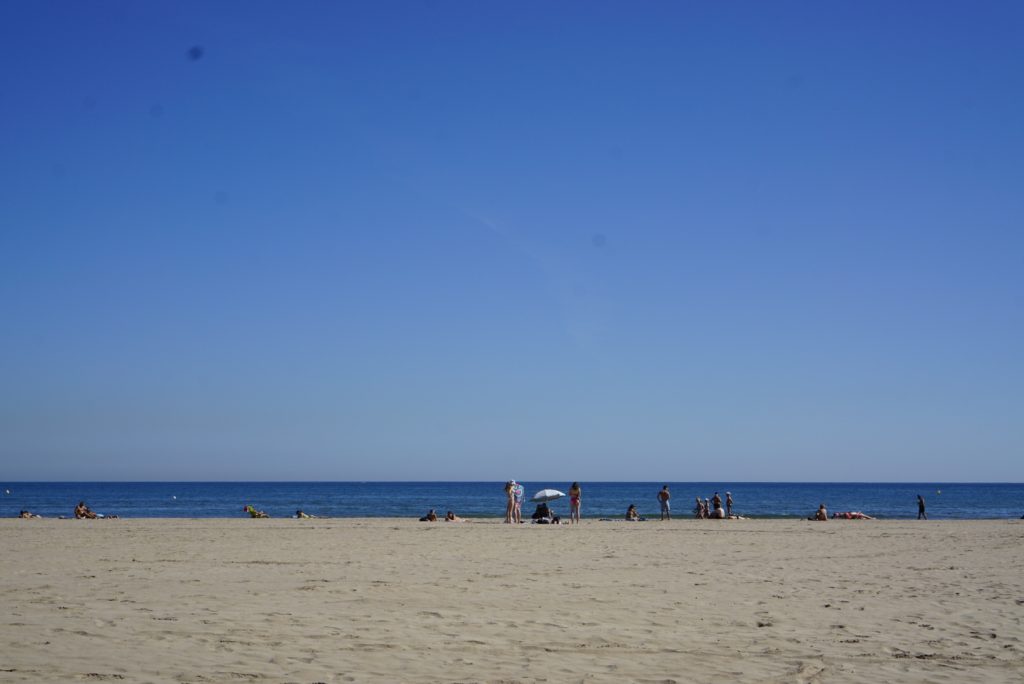



In the background below, a cruise ship is moored in the port. Valencia also has an enormous container port that ranks #1 in Spain and #2 in the Mediterranean (after Piraeus, Greece) for container traffic. You can just barely see some of the container cranes just above my right ear.

We rode our bikes past this school just as all the parents were lining up along the outer wall, apparently to pick up their kids. We stopped to figure out what was going on just as the school started playing music and all the parents filed in. Not sure if this was a routine daily thing or some special occasion. I will never drive an Audi, but if I did you sure wouldn’t find me in that parking lot. Crazy parking is hard to avoid in Spanish cities though. Spray painted traffic signs, too.

We found a little garden in a park with roses in bloom. Valencia appears to value its green spaces.
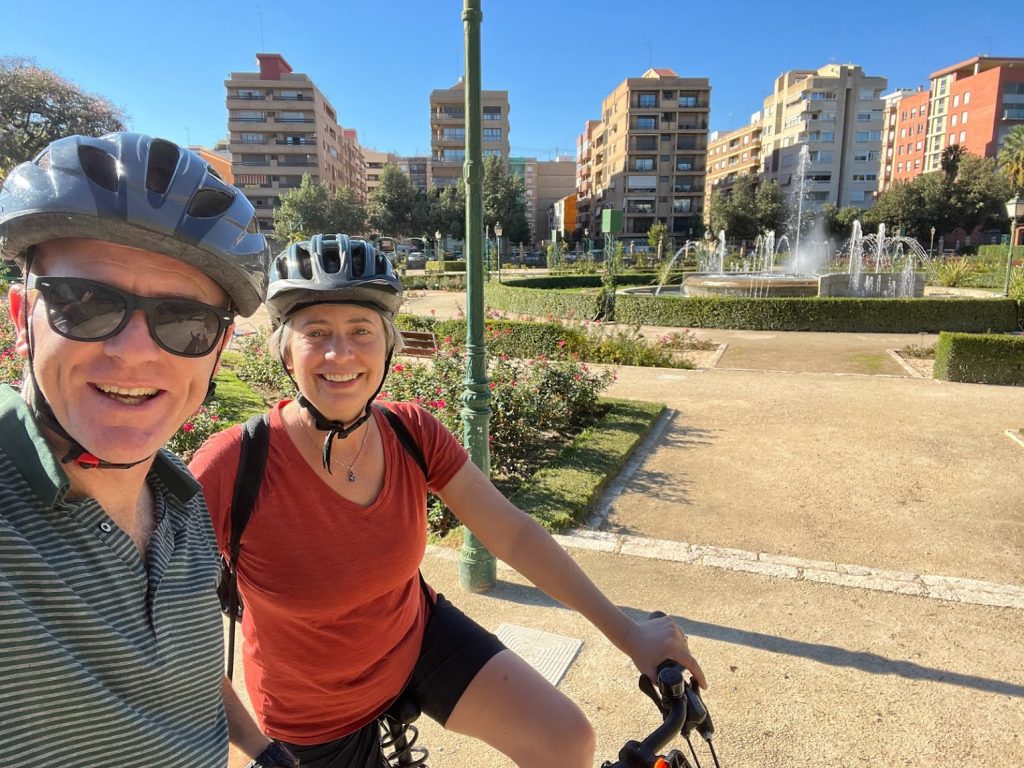
Crooked helmet, crooked smile. This is one of the paths in the greenway running through the city, which is generally sunken below street level since it’s a former river bed.

After school activity in the little park a block away from José and María’s apartment. It is completely empty most of the day but around 6 pm after school gets out (they start late and go late in Spain), it’s jam packed with children burning energy and parents visiting with one another. This picture understates the story but we didn’t want to appear creepy by taking lot of pictures. I let Lyn be the surreptitious photographer.

After we returned our bikes, we headed back to the apartment and saw a couple interesting shops. This was a candy store that made it hard not to stop and admire the presentation and vibrant colors. It had a nautical / pirate theme.

It’s hard to predict what photos will draw attention on Facebook but super realistic doll babies is definitely one of them. Or maybe it was Lyn’s smile people were responding to. This was a storefront window and DEFINITELY made it hard to keep walking past without stopping to gawk. Even after standing there for a minute starting at these babies, I had a hard time not believing they were real. Some of them had birthmarks and red spots on their head just like a newborn. The don’t cry and they won’t turn into teenagers, so I can see the appeal.
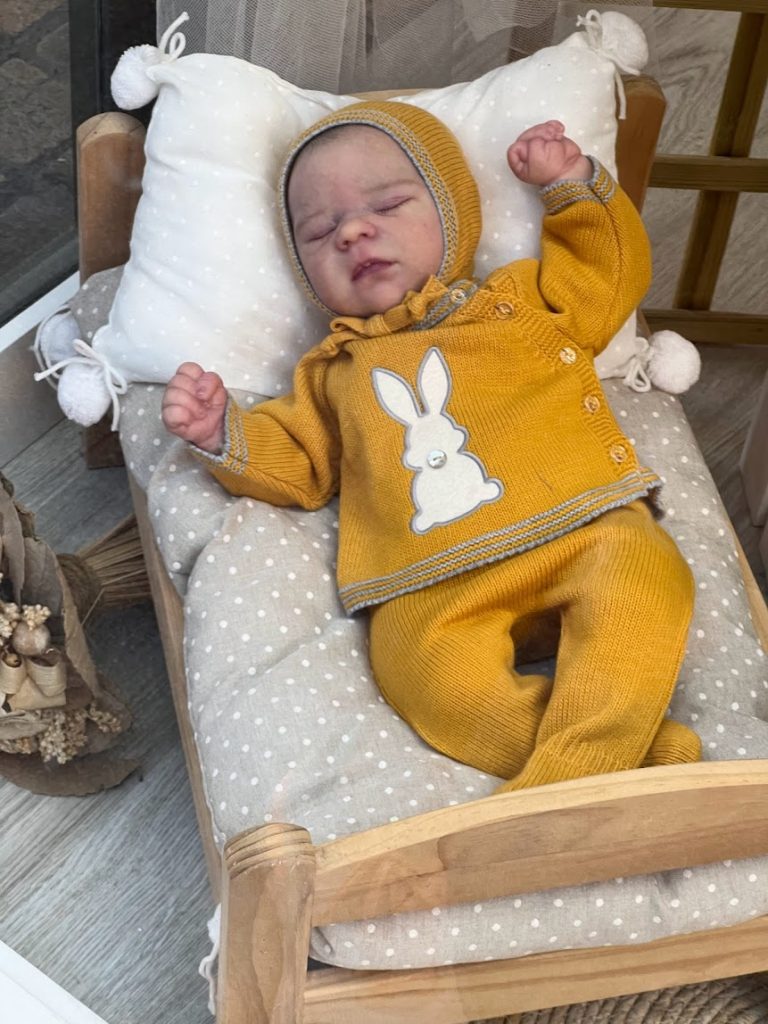


Glory Days in Valencia
On Saturday morning, José and María picked us up at the apartment in Valencia. We headed south toward Pedreguer but made two stops along the way. First, we hiked a trail to the ruins of a monastery in the mountains of southern Valencia. The second stop was in the city of Gandía for lunch and a visit to the birthplace of San Francisco Borja (Borgia is the more commonly seen spelling but it’s Italian because the family “Italianized” the name to improve their standing within the noble circles of influence and power. It was apparently successful because San Francisco’s grandfather became Pope Alexander VI (please don’t ask how popes can have grandkids; clearly a different age).
The Monastery of Santa María de la Murta sits in a valley just south of Valencia near the city of Alzira. In mid-October, this valley felt a lot like the mountains of California with its crisp pine trees, low humidity, and bright sunlight. The monastery is now in ruins but it had a vibrant history from roughly 1400 to 1800 and was associated with the Order of St. Jerome. The history of this site reportedly goes back to the pre-Moorish times but nothing remains of the structures prior to the 1400s. At its peak in the 1500-1700s, the monastery functioned as a pilgrimage site for nobles and a repository of important artwork. Around 1835, Spain went through an anti-clerical period called the “ecclesiastical confiscations of Prime Minister Mendizábal” in which the government and Spanish nobles seized monasteries in a combination of economic reforms and a land grab by the wealthy. The monastery of Santa María de la Murta became abandoned and fell into ruin over the next 150 years. Now it is owned by the local city government and has been restored as a public interest with historical signs, maintained hiking trails, and a parking lot.
María and José occasionally hike here and were gracious to show us around. In addition to the remains of the monastery, we saw the ruins of a house built by a wealthy family near the site and then later abandoned. We also saw a mill (molino in Spanish; moulon in French) for pulverizing olives to make olive oil. Finally, we saw an enormous pit used for the production of ice by dumping alternating layers of snow and straw during the winter.



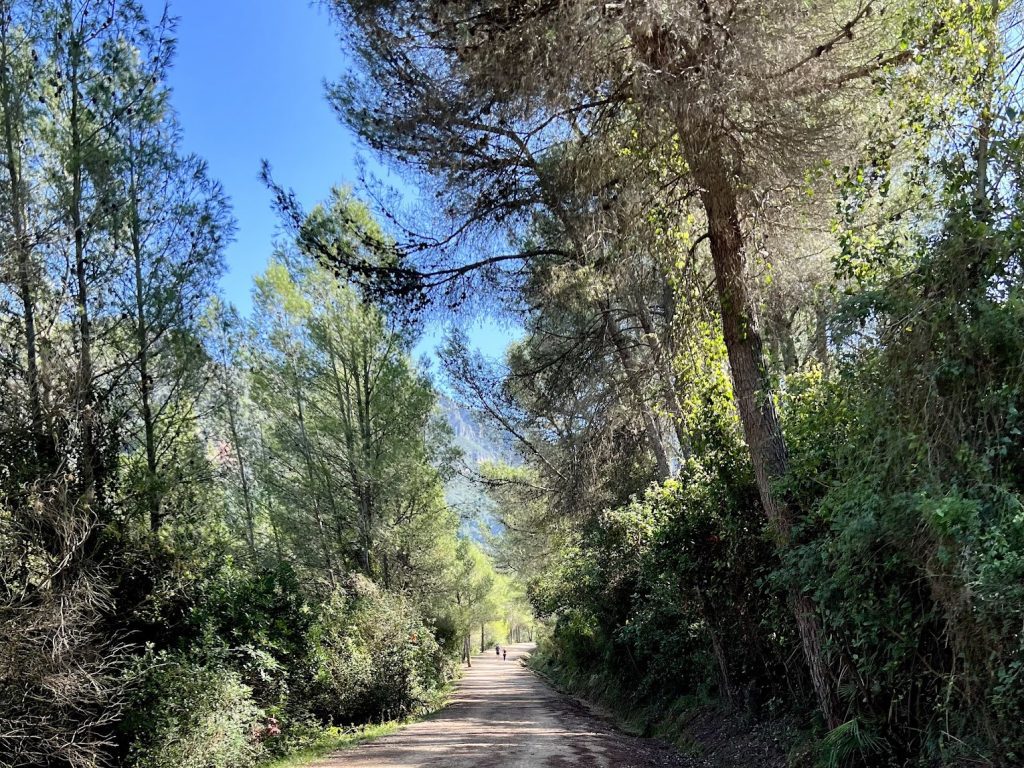
The monastery has definitely seen better days but is still very much intact. Despite falling into disrepair, the stone arches are still standing after 400+ years. In the stone mill for crushing olives, the olive oil flows to the channel on the outer perimeter of the stone surface and is directed into a container.




The monastery’s success was enabled by a steady water supply originated from up the hill and was directed down a channel for several hundred meters. The water still flows and we had fun hiking from the monastery up to its source. The stone bridge channels water; basically, it’ s a mini-aqueduct.





José was a superb tour guide. And dressed for the part. Here he demonstrates the elegant simplicity of a well-built aqueduct, water, and gravity.
The gate was locked but inside is the source of the spring coming from the mountain. At this point, we started heading downhill and soon got a view of the monastery from the opposite side.


Among the many things José explained to us, he pointed out that in this painting of the monastery at the peak of its prosperity, the artist depicts the mountains being bare of trees, ostensibly cut down by the four centuries of human habitation in the valley. We sometimes forget that environmental mismanagement is not a contemporary phenomena. Man has been screwing up the environment since harnessing fire and inventing the wheel. We just do it on an ever grander scale with each age of technological advancement.

“Glory Days, well they’ll pass you by…” – Bruce Springsteen
There’s a Spanish phrase for when you get hot that translates to “sweating like a chicken”. Between the climb and sunny weather, “estamos sudando como un pollo”. It was well worth the hike though and we worked up a good appetite.

We drove from La Murta to the city of Gandía for lunch at another one of José’s favorite restaurants that specializes in a dish called “Arròs al forn”. Forn is another Catalan word and sounds similar to the Italanian word “forno” and the Spanish word “horno”, all of which mean oven. Arròs al forn is similar to paella in that it’s a rice dish but it is baked in the oven and the particular version we ate was of terrestrial origin whereas traditional paella is mostly seafood.

We had lunch at a restaurant in one of Gandía’s central plaças. When we arrived, the plaça was adorned with two enormous sculptures of wide, thin faces. This, we learned, was another temporary exhibit similar to what we had seen in Valencia. I do not consider myself an art expert or even identify as an art enthusiast, but I recognized this art immediately as something I had seen before at the Museum of Fine Arts in Richmond, VA. That museum has a terrific sculpture garden and I remember a face similar to this dominating the landscape there. It doesn’t happen very often that I have this kind of artistic insight, but I was right. The artist is a Barcelona born sculptor named Jaume (that’s Catalan for James) Plensa. You can see his exhibit from 2016 in Richmond at:
https://jaumeplensa.com/works-and-projects/public-space/chloe-2016.
Of course, my recall is very slow so I only figured all this out after thinking about it for a while (like a few days). Nonetheless, it was pretty cool to be able to draw that connection from our life in Virginia to our travels in Europe. The sculpture itself is engaging because of how much the angle of viewing changes what you see. In a head-on view, the face is only 6-9 inches (15 to 23 cm).
On the opposite side of the square from our restaurant, a government building had four flags which, left to right, are the Gandia city flag (purplish), the Spanish national flag, the Valencian flag, and European Union flag.
We ate outside under the umbrellas (between the face and the tree in the photo below) and in the shade, which made the warm day feel just right for enjoying a terrific meal.
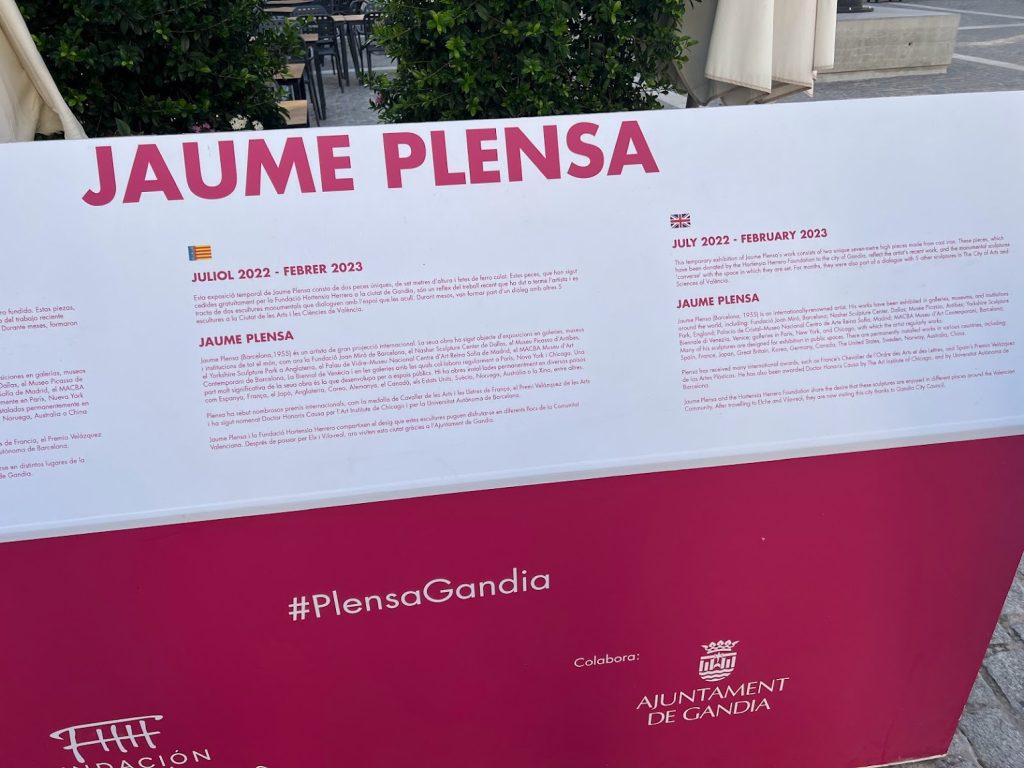


After lunch, we passed a museum just around the corner from the square. José and María explained that it was the Borgia Palace where San Francisco Borgia had been born in 1510. Prior to becoming a Saint and the third “Superior General” of the Jesuit Order, Francisco Borgia had been the Duke of Gandia. He was also the great-grandson of both Pope Alexander VI (Rodrigo de Borja) and King Ferdinand II of Aragon.
Of course, like everything else I had seen in Valencia, I didn’t immediately understand or appreciate the significant of what I was seeing, but when José and María asked if we were interested in visiting the palace, I hesitated only because I figured they had been before and was trying to determine if they were up for seeing it again. After some polite interaction trying to calculate what each person in our group really wanted to do, we all agreed we should check it out. Like the Church of San Nicolas, we got an audioguide with the admission and, wow, was it an interesting museum of a larger than life historical figure.
Given my amateur knowledge of everything, I need to be careful here in talking about Francisco Borgia, who is a canonized saint in the Catholic church. I am certainly not qualified to pass judgment on such an important and accomplished person, but I will say that the museum definitely validated the effectiveness of marketing to uphold the prestige and narrative of a family line. In the frescoe-painted ceilings, we saw several instances where Francis Borgia is looking down from his cloudy perch in heaven sitting comfortably with the holy trinity themselves. However Francis Borgia perceived his own humility, his ancestors certainly thought a lot of his saintly achievements and documented them appropriately in the family history artwork throughout the palace.
The other interesting narrative conveyed in the audioguide was that Francisco Borgia ostensibly decided he wanted to go to Rome and do God’s work there so he turned over his title as Duke of Gandia to his son, relinquished his authority, and went happily off to Rome. Wikipedia has a slightly different narrative and says “[After becoming the 4th Duke of Gandia], His diplomatic abilities came into question after his failed attempt at arranging a marriage between Prince Philip of Spain and the Princess of Portugal, thus ending a hope of bringing these two countries together, and resulting in his retirement as duke, handing his title to his son, Carlos.” Three years later his wife died and at that point he relinquished all of his titles and went to Rome to join the Jesuits. He was only 36 at that point and lived another 25 years making a significant impact within the Jesuit Order and becoming its third Superior General.
Bruce Springsteen wisely says “Poor man wanna be rich. Rich man wanna be king. And a king ain’t satisfied ’til he rules everything.” Through this lens of the human condition, I tend to think Wikipedia’s version of the story explains a bit more logically the context of Francis Borgia’s decision to “give up” his dukedom and reinvent himself as a Jesuit. Maybe he just didn’t have the stomach for the family politics and incessant intrigue, but that doesn’t really fit with how you become Superior General a religious Order that influenced the course of history. Regardless of his motives, Francis Borgia definitely had many accomplishments in his storied life.
The palace by itself was impressive to see and reflects the prestige and power of the Borgia family. Part of the palace remains as a residence for Jesuit priests. The palace website includes a pretty good YouTube video to dramatise the history and cultural significance of the palace:
https://www.palauducal.com/en/
https://youtu.be/AXYHb0Ek
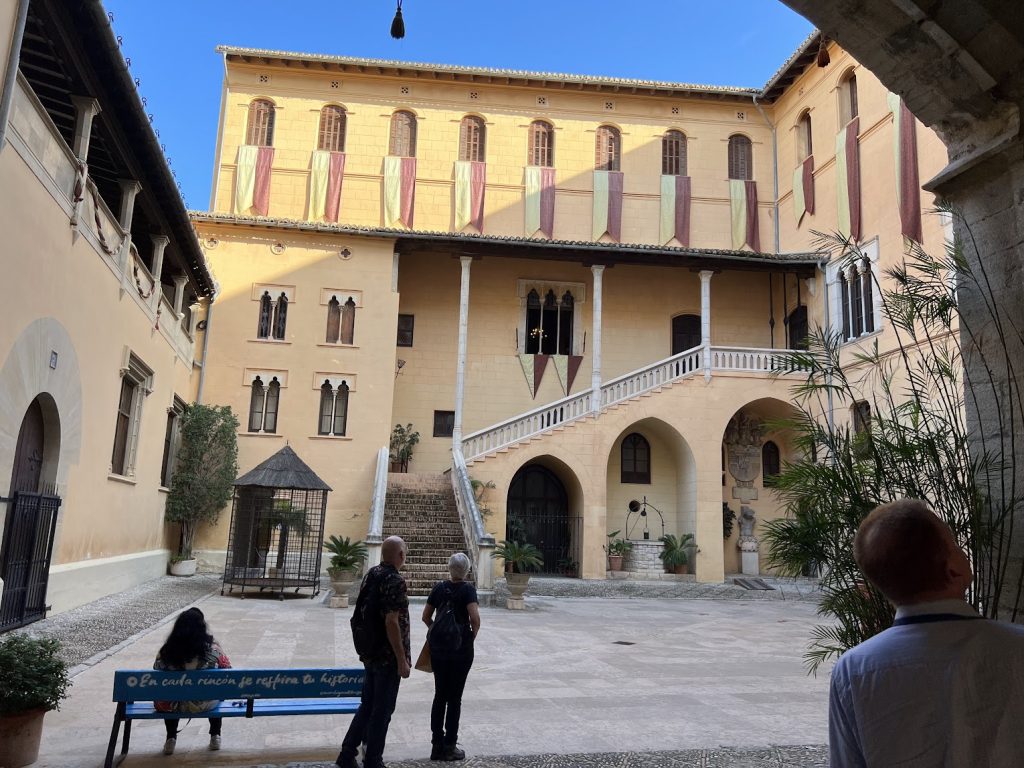





The palace has several displays of Valencian tile preserved from the 15th century. 500+ years and still looking good. This blue and white tile comes from a town called Manises and was once a signature Valencian product in the Mediterranean world.


The ceilings gave us some more neck strain; very interesting details. The symbols over the knights’ helmets represent three different kingdoms. Lot of imagery going on.

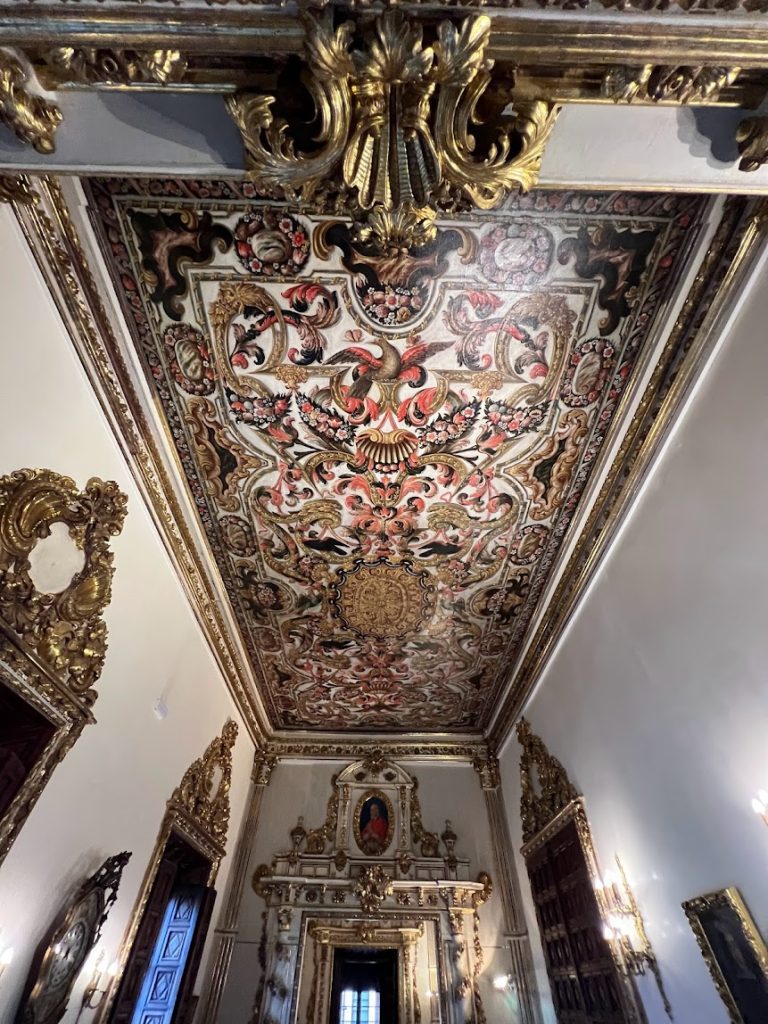
On the left is a ceramic “death mask” of Saint Francisco Borgia used for funerary purposes. Artists who painted St. Francis Borgia after his death used this as a model of what he looked like. He is depicted with a beard in most artwork. Note the five points above the case; this is part of the Borgia family crest (brand) as can be seen in the ceramic tiles above.



At age 29, four years before he became the 4th Duke of Gandia, Francis Borgia was given the task of escorting Queen Isabella of Portugal to Toledo, Spain for her interment. According to some sources, his duty included testifying that the casket contained the queen’s body. They apparently had to open the casket and the body was quite decomposed. By some accounts, Francisco experienced a moment of grace and declared “I shall never again serve a mortal master”. By other accounts, the experience jarred his sense of mortality and he committed himself to doing God’s work. He nonetheless became the 4th Duke a few years later when his father died and decided to become a Jesuit only after his own wife died. 500 years is a long time to understand exactly what happened, but his life story remains deeply interwoven with that moment when he saw the rotting corpse of the once-beautiful Queen Isabella. This statue captures that moment although it’s very unlikely he actually touched her body.
More here on Francisco’s moment of clarity:
https://catholicmagazine.news/st-francis-borgia-a-spanish-duke-at-the-head-of-the-company-of-jesus/
The exterior of the palace is also quite beautiful. The building was renovated in recent history in preparation for San Francisco Borgia’s 500th birthday in 2010.

Great visit and another reminder how rich (and complex) history can be in European countries. I’m pretty sure the house where I lived as a child will be long gone in 2470.
We left Gandia and headed for José and María’s home in Pedreguer, which is a wonderful property on the edge of the town with a sizable lot that contains a variety of fruit trees and three impressive antennas for shortwave radio. They also have fruit trees, including (lots of) avocados. Talk about paradise.


José gave us a tour of his “radio room” and a brief demonstration of his system’s performance. In a span of just 20 minutes, we heard shortwave (ham) radio operators in Germany, Pennsylvania, and California. José even spoke to the guy in California who was Mexican-American, so they conversed in Spanish rather than English.


EA5DFV is on the air.
We got to FaceTime with Irene for a few minutes. Both she and her brother are studying overseas this year (the Europeans call study abroad an “Erasmus year”). Irene is in Prague and her brother is in Iceland (we missed our chance to see him during our brief visit there in September but had a chance to say hello to him on FaceTime as well.).

Mediterranean Coast – Spain’s “Not so Bad lands”
If you are ‘waiting for a sunny day’ in Valencia, you don’t have to wait long. We got up the next morning, had a nice Spanish breakfast at the kitchen table and then made a plan to see explore the beautiful coastline of Valencia. Our adventure would take us from the city of Dénia to the city of Benidorm on a beautiful Sunday.
After passing through Dénia, we stopped at Cap de Sant Antoni (Cape San Antonio) and took a short hike. On a very clear day, you can see the island of Ibiza 60 miles (100 km) from this perch. The cape also has a commanding view of the city of Xàbia (in Valenciano; also called Jávea in Spanish) and especially its port.

Looking north at the boats coming out of Dénia

Looking south at the bay and the next cape (Cap de San Marti).

Xabia harbor. You can also see the terracing for growing grapes although these are not presently being cultivated. The proper town of Xabia is set back from the water and can be seen in the background. The residential growth along the water is a fairly recent phenomena since the coast became a major tourist draw in the 1970s.
We drove south and stopped for a second hike near Cap Blanc in the municipality of Benissa, which reminded us of San Diego. For our second hike of the morning, the sun was getting higher and hotter. “Estoy sudando como un pollo.”
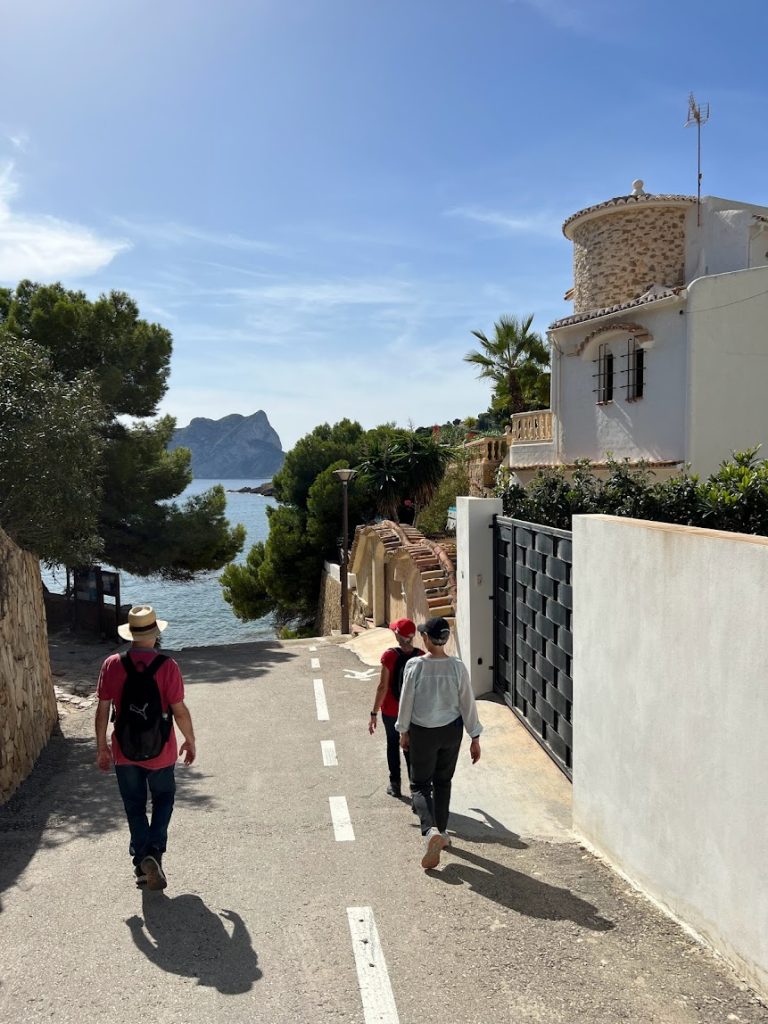



We backtracked just a little and had lunch at another José-approved restaurant in Moraira. Shared a number of tapas and it was all fantastic.
Mussels, fried artichokes topped with jamon iberico (Spain’s answer to prosciutto), pickled cod with baked eggplant on flatbread. One of the best meals we’ve ever had.



After lunch, we weighed our options. José suggested we visit the city of Benidorm. I got excited about this because I recall Navy ships doing port visits there back in the day and the liberty stories are somewhat epic. Benidorm has no harbor for Navy ships to go pierside so I think it was more of a 1980s and 90s thing when ships did deployments just to the Mediterranean and anchored offshore for liberty ports. In any case, legendary liberty has a long half-life so I was interested in checking it out.
Benidorm didn’t disappoint. It is a very well developed (perhaps a touch over developed even) with a gorgeous beach and boardwalk amid a dense collection of hotels and high rises. It has a large expatriate population, mostly retired, at this time of year and then also attracts families and young people in the summer time. Benidorm has a small point in the middle of the bay, creating essentially a north bay and a south bay which makes it difficult to take in the entire Benidorm beach front at once. Even when you are only seeing half of it though, it’s quite impressive in its scale.
We walked the entire boardwalk of the southside bay. Like Valencia and Gandia, the boardwalk featured a number of temporary sculpture exhibits that add a lot of character to the scene. I can’t quite compare Benidorm to anything I have seen in the states. I’m pretty sure I would not want to be there in the summer at peak tourist season because it is crowded enough in mid-October and just seeing all those hotels, I can only imagine how packed the streets, sidewalks, and beaches must be at peak season. Construction of this tourist area began in the 70s and continues today so you see a mix of the old and new in Benidorm’s dense jungle of hotels and condos.

From architecture to people watching to advertisements to artwork to seaside vistas, the long boardwalk is interesting every step of the way. The sign on the right basically says Benidorm enjoys 320 days of sunshine per year; perhaps the second happiest place on earth.





We climbed the point of land in the middle of the bay. The phoot on the left is looking south back to where we had just walked. The car is parked near the tallest building (above the group of five palm trees). Sunset brings out the residents for the evening “paseo” walking hour.



Farewell Valencia y Feliz Cumpleaños a María!
We had another nice Spanish breakfast and then took a short tour of Pedreguer on foot. José and María live on the edge of the town so you don’t see the center area driving in and out of the neighborhood.
Walking to it on foot is an entirely different experience and, like so many other Spanish towns, Pedreguer has loads of character and charm. We also found out it was María’s birthday!
The weather was a bit overcast although likely to burn as the morning progressed. After our walk, we got back in the car and went to Valencia where José and María dropped us at the train station for our jaunt to the northwest of Spain on the Alta Velocidad España (AVE) train.
We packed a lot of activity into a short window and learned much more about Catalonia and the Valencia region. We enjoyed every moment of the visit and look forward to hosting José and María when they come visit Wisconsin.
First we walked up the hill to the small church overlooking the city. I should have photographed the church but the view over the town was just so pleasant. Pedreguer’s main church is in the town (hard to see in this photo).



Pedgreguer is about 5 miles (8 km) from the coast. This mountain lies between Pedreguer at Cap Sant Antoni where we started our adventure the previous day.

You can see just a little bit of the church to the right of Saint Anthony (Sant Antoni). The second photo is looking down the path leading to the hilltop church.
Pedreguer’s town crest in mosaic by the church along with the toes of Lyn’s Hokas. The statue is part of a recurring theme we have seen throughout Spain in which the traditional roles and dignified hard work of women are celebrated. In this statue, the woman is carrying a bag on her back associated with working in the fields.


Before getting in the car for a ride back to Valencia, we got one last shot of the biggest Bruce Springsteen fan and biggest radio antenna in the province of Valencia . Had to use the .5x lens to get the tower’s full height, which is why my feet look like clown shoes.
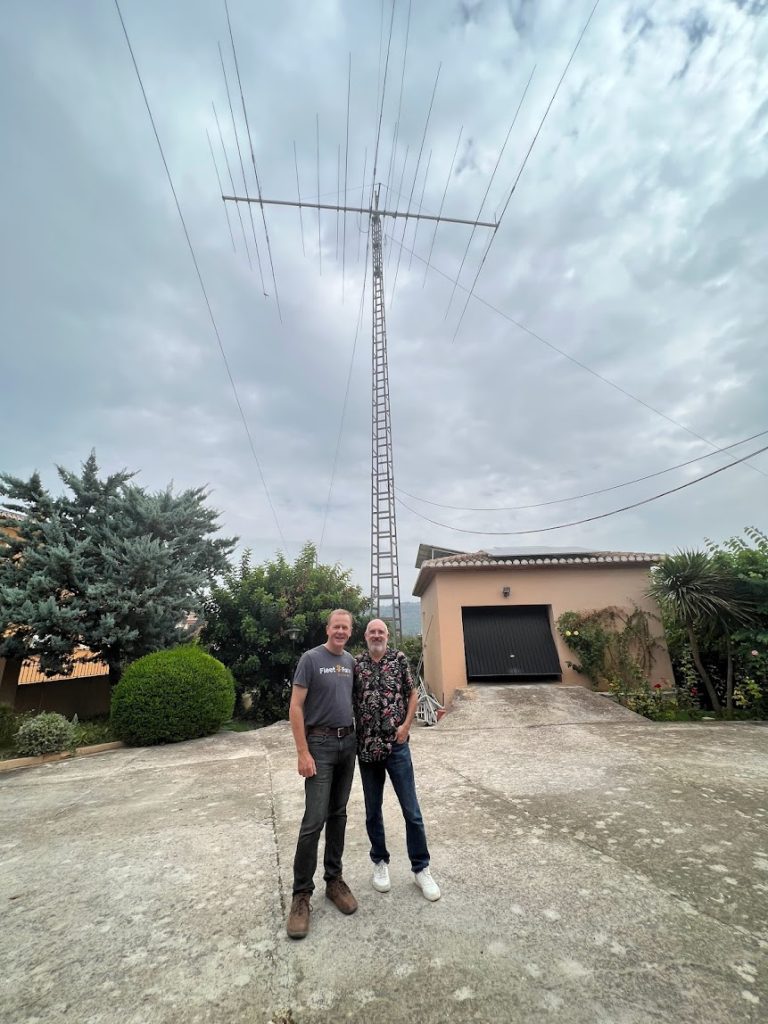
The Alta Velocidad España (AVE; also a play on the word bird) covered the 200 miles (360 km) in 90 minutes. about 130 mph and smooth as can be. Very comfortable and fun way to travel.
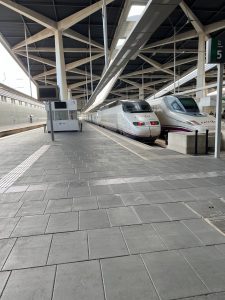

Moltes gràcies a José and María for an excellent visit, wonderful conversation, and awesome food.



